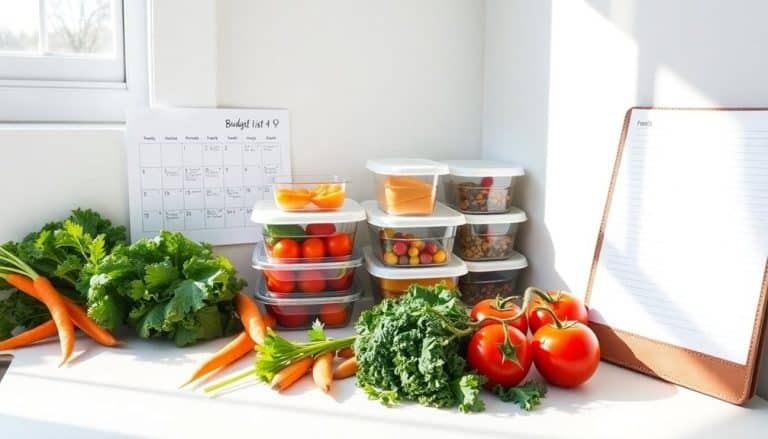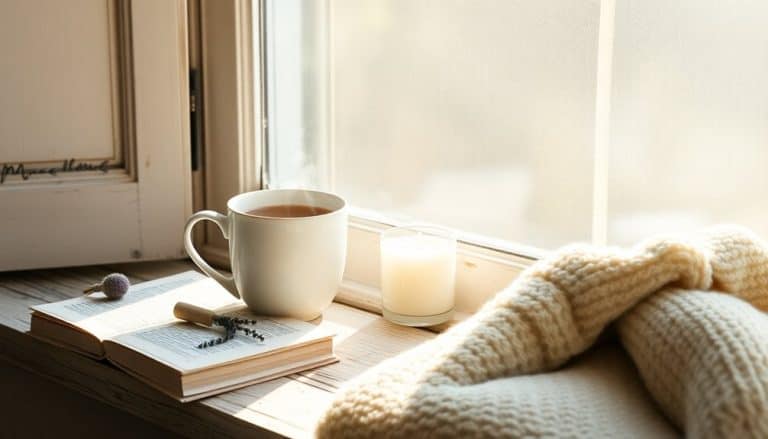This website contains affiliate links. Some products are gifted by the brand to test. As an Amazon Associate, I earn from qualifying purchases. The content on this website was created with the help of AI.
You’ll love these seven budget-friendly upcycling projects using items you already have at home. Transform mason jars into versatile storage containers for kitchen staples or bathroom essentials. Turn old t-shirts into durable shopping bags without any sewing skills. Create a charming message board from wine corks and a wooden frame. Repurpose tin cans into decorative planters for your herbs and flowers. Fashion wall art from damaged books by folding pages into artistic designs. Build rustic shelving from pallet wood for unique storage. Organize drawers with custom cardboard dividers covered in contact paper. These eco-friendly transformations are just the beginning of your sustainable DIY journey.
Key Takeaways
- Transform old t-shirts into reusable shopping bags by cutting handles and securing the bottom without sewing.
- Create organization systems from cardboard boxes by measuring, cutting, and covering them with contact paper for drawer storage.
- Convert empty mason jars into versatile storage containers for kitchen, bathroom, office, or garden supplies.
- Repurpose tin cans into decorative planters by adding drainage holes and personalizing with paint or twine.
- Turn wine corks into functional message boards using a picture frame and hot glue for home office organization.
Mason Jar Storage Solutions
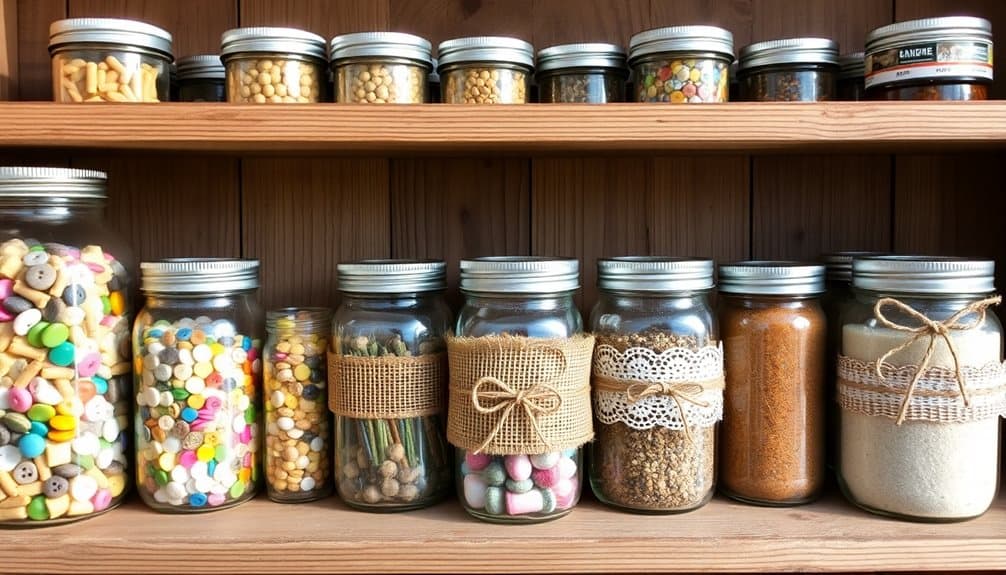
Everyone has a few spare Mason jars tucked away in their cabinets, and they’re perfect for creating stylish, eco-friendly storage solutions throughout your home. You’ll love how these versatile containers can organize everything from craft supplies to bathroom essentials while reducing plastic waste and saving money.
Transform your kitchen by using Mason jars to store dry goods like pasta, rice, and beans. Simply clean the jars thoroughly, add airtight lids, and create custom labels. In your bathroom, they’ll elegantly hold cotton balls, Q-tips, and bath salts. You can even spray-paint the lids to match your decor.
For your office or craft room, use smaller jars to organize paper clips, rubber bands, pins, and buttons. Mount them under shelves by securing the lids with screws, creating accessible upside-down storage that saves desk space. In the garage, larger Mason jars work perfectly for storing nails, screws, and other hardware – the clear glass makes it easy to find what you need quickly.
Don’t forget your outdoor spaces! These durable jars can hold garden seeds, small tools, and even serve as solar lights when fitted with outdoor LED strips. When used as outdoor lighting, Mason jar solar lights can provide 6-8 hours of illumination after charging in direct sunlight.
T-Shirt Tote Bags
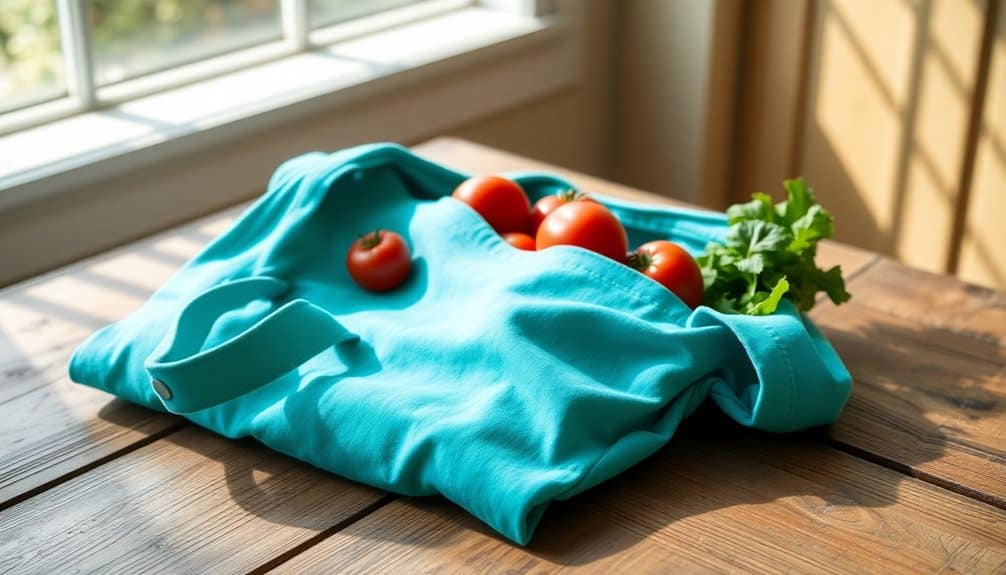
Old t-shirts frequently end up forgotten in drawers or destined for the landfill, but you can easily transform them into sturdy, washable tote bags without any sewing required. Simply lay your t-shirt flat, cut off the sleeves and neckline to create handles, then cut fringe strips along the bottom edge about 4 inches up. Tie these strips together tightly in double knots to create a secure bottom, and you’ve got an eco-friendly shopping bag.
These upcycled tote bags are perfect for various uses, from grocery shopping to beach trips. You’ll want to choose shirts with thicker fabric for durability, and you can even layer two shirts together for extra strength. Get creative with designs by selecting shirts with interesting patterns or graphics that’ll show off your personality while reducing textile waste.
- Choose shirts with minimal stretched-out areas or holes to guarantee your bag’s durability
- Consider cutting the bottom hem off first to make the fringe-cutting process easier
- Double-knot each pair of fringe strips carefully to prevent unraveling during use
The best part? When your tote gets dirty, just toss it in the washing machine like any other shirt.
Wine Cork Message Board
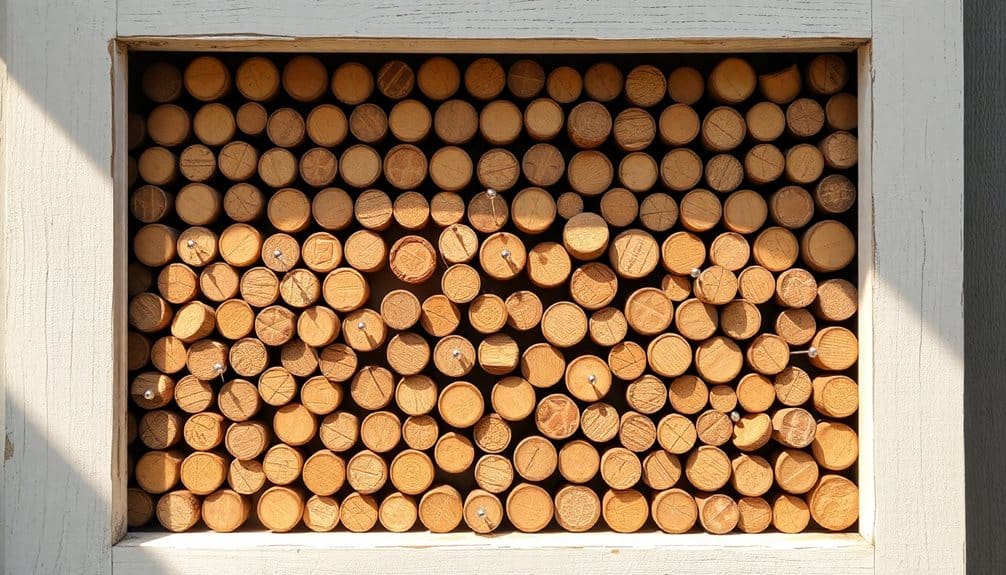
Wine corks you’ve collected can be transformed into a charming, functional message board that’s perfect for your home office or kitchen. Instead of tossing these sustainable stoppers into the trash, you’ll give them new life while creating an eco-friendly organizational tool that doubles as wall art.
To create your cork board, you’ll need approximately 50-80 wine corks (depending on your desired size), a wooden picture frame, a hot glue gun, and some sturdy backing material like plywood or thick cardboard. Remove the frame’s glass and backing, then arrange your corks in neat rows or a creative pattern. You can slice the corks lengthwise to achieve a flat mounting surface that’ll stick better to your backing.
Secure each cork with hot glue, working systematically from one corner to guarantee straight lines. Once you’ve filled the frame, let it dry completely before hanging. Your new message board will grip push pins firmly, and the natural variations in the corks create an interesting textural element. For added functionality, paint some corks with chalkboard paint or add small hooks between them for hanging keys.
Tin Can Planters

Just like those wine corks, empty tin cans from your kitchen provide another fantastic opportunity for creative reuse. Transform these everyday containers into charming planters for your herbs, succulents, or small flowering plants. Before you begin, thoroughly clean the cans and remove their labels. Using a hammer and nail, punch several drainage holes in the bottom to prevent water-logging your plants.
To make your tin can planters truly unique, you’ll need to prep the surface for decoration. Sand any sharp edges for safety, then wipe the exterior with rubbing alcohol to remove residue. You can paint them with rust-resistant outdoor paint, wrap them in twine or rope, or create patterns using weather-resistant washi tape. If you need more vertical storage space, consider installing closet rod extenders to hang multiple planters at different heights.
- Create a vertical garden by mounting multiple painted cans on a wooden pallet or fence
- Group different-sized cans together for an industrial-chic centerpiece
- String them together with sturdy rope to make a hanging garden
Add potting soil, transplant your chosen plants, and position your upcycled planters in a spot with appropriate sunlight. Remember to drill holes in your mounting surface if you’re creating a wall display, ensuring proper support for when the cans are filled with soil and water.
Old Book Wall Art

Beloved books that are too damaged to read can find new life as stunning wall art in your home. By transforming old pages into three-dimensional art pieces, you’ll create eco-friendly decor while preserving literary memories. Start by carefully removing pages from the book’s spine, then fold them using precise accordion or cone patterns to create depth and texture.
For a dramatic circular design, roll individual pages into tight coils and arrange them in a spiral pattern on a sturdy backing board. You can enhance the vintage appeal by lightly tea-staining the pages or leaving them natural for a clean, modern look. Secure each element with acid-free glue to prevent yellowing over time.
Try crafting butterflies by folding pages into delicate wings, or create geometric shapes through strategic page folding. You’ll want to spray your finished piece with a clear UV-resistant sealant to protect it from fading. Mount your creation in a shadowbox frame or directly onto canvas for added dimension. Consider grouping several book page art pieces together to create an eye-catching gallery wall that tells your unique story while keeping old books out of landfills. These literary masterpieces complement your autumn home decor perfectly when displayed alongside warm-toned accessories and seasonal elements.
Pallet Wood Shelving
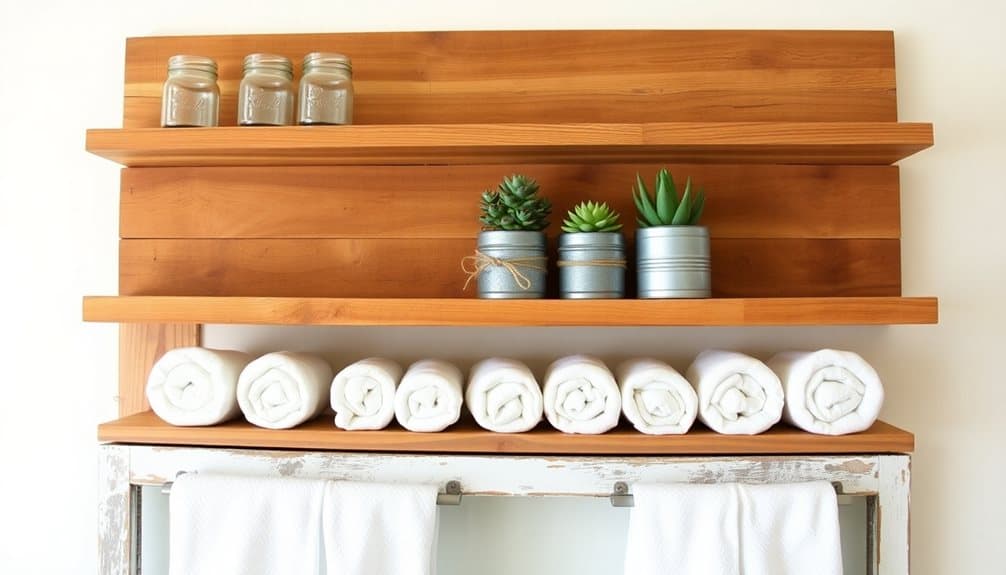
When you’re looking to add rustic storage solutions to your home, wooden shipping pallets offer an incredibly versatile and eco-friendly material for creating custom shelving. You’ll need to carefully disassemble the pallet, sand down rough edges, and treat the wood to prevent splinters. With proper preparation, you can transform these discarded materials into stunning wall-mounted shelves that’ll add character to any room.
Before starting your project, verify you select pallets marked with “HT” (heat-treated) rather than chemically treated ones. Once you’ve gathered your materials, you can customize the shelf design to fit your space perfectly. Consider leaving the natural weathered look or adding a protective finish to enhance the wood’s durability. Stylish storage crates can be integrated into your pallet shelving design for additional organization options.
- Create floating shelves by mounting individual pallet boards directly to wall studs using heavy-duty brackets.
- Design a ladder-style bookshelf by connecting pallet slats at angles for a unique display piece.
- Build box-style storage units by combining pallet boards into cube shapes, perfect for organizing small items.
Your finished shelving won’t just save money – it’ll give new life to materials that might otherwise end up in landfills while adding distinctive charm to your living space.
Cardboard Drawer Organizers

Moving from wooden storage to paper-based solutions, cardboard boxes from your recycling bin can revolutionize your drawer organization. You’ll need clean, sturdy cardboard boxes, a sharp utility knife, ruler, pencil, and decorative paper or contact paper if desired. Start by measuring your drawer‘s internal dimensions, accounting for height clearance and drawer slides.
Cut your cardboard boxes to create custom-sized compartments, making sure to leave tabs for connecting pieces. You can create various configurations: long strips for utensils, small squares for office supplies, or medium-sized sections for clothing items. Reinforce corners by folding the cardboard twice and securing with strong adhesive or small tabs that interlock.
To extend your organizers’ lifespan, cover them with contact paper or decorative wrapping paper, which also adds water resistance and style. Focus on high-traffic drawers first: kitchen utensils, desk supplies, or bathroom items. You can even create stackable layers for jewelry boxes or craft supplies. By repurposing cardboard that would otherwise end up in landfills, you’re creating practical storage solutions while reducing waste. Keep spare cardboard on hand to replace sections that wear out over time. For a more durable alternative, consider replacing your most-used cardboard organizers with stackable plastic bins that offer similar customization options.
Frequently Asked Questions
How Long Does Upcycled Household Decor Typically Last Before Needing Replacement?
You’ll find that upcycled household decor‘s lifespan varies greatly depending on your materials and craftsmanship. Well-made pieces can last 5-10 years or more! Solid wood items, properly sealed mason jars, and metal decor tend to endure longest. You’ll extend your upcycled items’ life by keeping them away from moisture, direct sunlight, and temperature extremes. Regular dusting and maintenance will help preserve your eco-friendly creations.
Can Upcycling Projects Be Safely Used Around Pets and Children?
You’ll be over the moon to know that most upcycling projects can be pet and kid-friendly with proper planning! Start by avoiding toxic materials like certain paints, glues, or sharp edges. Choose water-based, non-toxic finishes and child-safe hardware. Sand down rough spots, secure loose parts, and keep small components out of reach. Remember to supervise DIY activities and always check that materials are properly sealed and cured before use.
What Household Items Should Never Be Used for Upcycling Projects?
Don’t use household chemicals, old batteries, moldy materials, or broken electronics in your upcycling projects. These items can release toxic fumes or cause injuries. You’ll also want to avoid rusty metal containers, items with sharp edges, or anything treated with lead-based paint. Steer clear of old plastic containers that previously held harsh chemicals, and never repurpose expired medication bottles.
Are There Any Legal Restrictions for Selling Upcycled Items From Home?
You’ll need to check your local business regulations before selling upcycled items from home. Start with obtaining necessary permits, sales tax licenses, and business registration. Don’t sell items with trademarked logos or copyrighted designs without permission. If you’re using online platforms like Etsy or eBay, review their policies carefully. Health and safety regulations apply when upcycling items that’ll come in contact with food or children’s products.
How Can I Remove Stubborn Adhesives From Materials Without Damaging Them?
Did you know that the average household has over 40 items with adhesive residue that could be salvaged? You’ll love these natural removal methods! Start with warm vinegar or coconut oil, letting it sit for 15 minutes to break down the sticky residue. For tougher adhesives, try rubbing alcohol or a paste made from baking soda and coconut oil. Gently scrape with a plastic card, and you’re good to go!



